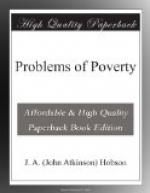3. Along with the movement towards a national organization of the workers in a trade, or in some cases prior to it, is the growth of combined action between allied industries, that is to say, trades which are closely related in work and interests. In the building trades, for example, bricklayers, masons, carpenters, plasterers, plumbers, painters and decorators, find that their respective trade interests meet, and are interwoven at a score of different points. The sympathetic action thus set up is beginning to find its way to the establishment of closer co-operation between the Unions of these several trades. The different industries engaged in river-side work are rapidly forming into closer union. So also the various mining classes, the railway workers, civil servants, are moving gradually but surely towards a recognition of common interests, and of the advantage of close common action.
4. The fact of the innumerable delicate but important relations which subsist among classes of workers, whose work appears on the surface but distantly related, is leading to Trade Councils representative of all the Trade Unions in a district. In the midland counties and in London these general Trade Councils are engaged in the gigantic task of welding into some single unity the complex conflicting interests of large bodies of workmen.
5. An allusion to the attempts to establish international relations between the Unions of English workmen and those of foreign countries is important, more as indicating the probable line of future labour movement, than as indicating the early probability of effective international union of labour. Though slight spasmodic international co-operation of workers may even now be possible, especially among members of English-speaking races, the divergent immediate interests, the different stages of industrial development reached in the various industrial countries, seem likely for a long time at any rate to preclude the possibility of close co-operation between the united workers of different nations.
Sec. 6. Parallelism of the Movements in Capital and Labour.—Now this movement in labour, irregular, partial, and incomplete as it is, is strictly parallel with the movement of capital. In both, the smaller units become merged and concentrated into larger units, driven by self-interest to combine for more effective competition in larger masses. The fact that in the case of capital the concentration is more complete, does not really impair the accuracy of the analogy. Small capitals, when they have co-operated or formed a union, are absolutely merged, and cease to exist or act as individual units at all. A “share” in a business has no separate existence so long as it is kept in that business. But the small units of labour cannot so absolutely merge their individuality. The capital-unit being impersonal can be absolutely merged for common action with like units. The labour-unit being personal only surrenders part of his freedom of action and competition to the Union, which henceforth represents the social side of his industrial self. How far the necessity of close social action between labour-units in the future may compel the labourer to merge more of his industrial individuality in the Union, is an open question which the future history of labour-movements will decide.




